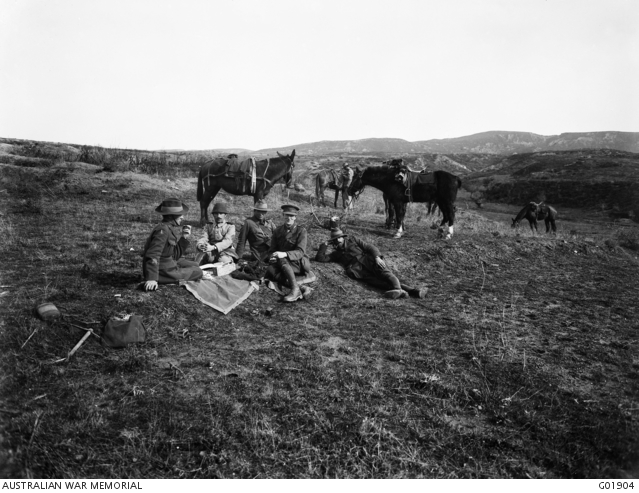A personal mission
“These events happened a number of years ago. Their hitherto unwritten story lies in the faded diaries and rain-and-mud-stained field-books beside me as I work.”
Charles Bean, Gallipoli Mission (1948)
To write the official history of the Gallipoli campaign, in late 1918 Charles Bean revisited the battle fields and gathered information. Bean had an immense amount of work ahead, checking the details of actions, dates, people, and places, as well as interviewing veterans of British and Turkish forces. He also needed to assemble a team to help with photography, surveying, collecting relics, sketching and painting.
By January 1919 Bean had brought his team together in London and gained the necessary approvals and promises of assistance. Now known as the Australian Historical Mission, the group was to undertake research work on the Gallipoli peninsula, undertaking matters relating to war graves, collecting relics, and gathering information for the official history.
The team travelled to Gallipoli by train and ship, endured multiple baggage thefts and debilitating seasickness. After reaching Gallipoli, the members of the team camped in different locations close to their areas of interest. As accommodation was scarce, camping provided the benefit of proximity. Bean’s notes show that camp life could be hard, but was fun and rewarding. The team members had their own war experiences, and their notes suggest the work of the mission was a welcome change.
Hubert Wilkins MC, Bean’s chief photographer, included photos of the team in his record.
Group photo of some of the Mission team, including Charles Bean and Zeki Bey. Photograph by H. Wilkins MC.
George Lambert, the team’s artist, was keen to develop an extensive portfolio. To assist himself in selecting subjects for new art during the fieldwork, Lambert kept asking Bean: “what are your orders today?” Bean rated him highly as entertaining company. Lieutenant Buchanan and his assistant provided valuable support in mapping and surveying that helped war-graves work and the official history. Their work also proved useful for the creation of landscape models later used in the Memorial’s galleries. Lieutenant John Balfour, selected as Bean’s assistant, had useful experience in the army’s war records section.
Bean’s notes indicate that he was delighted with the work and results of the mission. He undertook lengthy companionable interviews with Turkish officers, including Zeki Bey, who became a friend to Bean.
Anzac Cove as it appeared in February 1919. Photograph by H. Wilkins MC.
Bean stoked his sense of mission by thinking about what the proposed memorial–museum (which would become the Australian War Memorial) could offer returned servicemen and future generations of visitors. Bean also valued his time spent finding and collecting war relics, conducting daily searches to add to the material already being sent back to Australia. He noted “for the museum” on items including uniform badges and cartridge cases. One of the smaller treasures discovered were some pine-tree seeds near the tree at Lone Pine Ridge. The original tree, well-known to the campaign troops in 1915, and sometimes known as “Lonesome Pine”, had nearly been destroyed, but some seeds were found and collected.
The Lone Pine at Gallipoli. A similar tree is growing at the Australian War Memorial.
The Memorial’s Lone Pine appears in this photo of the opening of the Memorial in 1941.
When the Australian War Memorial opened in Canberra on 11 November 1941 a new world war was in progress and the Official History of the First World War was a celebrated work of Australian history. At this time Bean returned to his notes and diaries of the 1919 adventure, and wrote the Gallipoli Mission book, which gives an account of the Gallipoli battlefields, and details the establishment of the Memorial’s collection and the people who helped establish it.
Bean’s notes from the mission – a mix of typed pages and handwriting, with various small sketches – are part of the Australian War Memorial’s Official Records. They have been digitised and are publically available here on the Memorial’s website. They show his record of the progress of various mission activities, and personal experiences during fieldwork. Decades later, Bean used those notes to write Gallipoli Mission.



